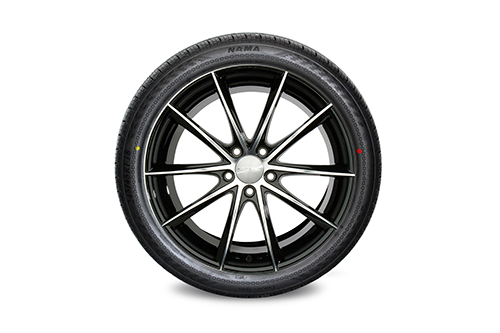Notice Red & Yellow Paint Dots When Installing Tires
Looking at the DOT number on the sidewall of your tire will give you the information needed to locate its manufacturing facility. While looking at the sidewall, you may have noticed something else you didn’t recognize. If your tires are new or recently installed, you may have noticed a couple of red and yellow paint dots.

If you think you’re just seeing spots, don’t worry – that’s completely normal. The spots on the sidewall of your tires were specifically placed by the manufacturer to guide the tire installation process. In fact, these colored dots serve a specific purpose in helping the tire technician correctly balance the tire.
Creating a tire that is perfectly balanced and perfectly round is nearly impossible. Manufacturers make sure to label these inconsistencies with dots, so they can be corrected during the mounting process. Not all tires have these temporary markings and it’s also uncommon to see them on used tires because they can get scuffed off easily.
Most people will have their tires installed by a seasoned tire technician to ensure that mounting and balancing are done properly. Tire mounting and balancing requires special tire machines and balancing process involving weights, lubricants, valve stems, and other things the average person doesn’t normally have on hand.
Because the process is so specific, it’s important to know whether your tires are being mounted correctly or not. That’s where the spots come in. Assuming you have them, there are two methods you can use to determine whether your tires were mounted correctly or not.
Weight method
First, locate the valve stem on the side of your tire. If it’s lined up with one of the colored dots, the person who mounted your tire took heed of the label and installed it correctly. If the valve stem is located at the heaviest point on the tire, it will be lined up with a yellow dot on the sidewall. When a red dot is lined up with the valve stem you can assume that the valve is at the tire’s lightest point.
After a tire is mounted, its balance is checked on an automated machine that will locate any lighter weight areas. The machine will notify the tire technician to install tire weights at various points around the rims perimeter to balance the tire.
Uniformity Method
Your steering, traction, braking, and load support capabilities are all dependent on the radial force variation in your tire. Maximum radial force and runout (the difference between the highest and lowest weight points) is marked by a red dot. Radial force, as well as runout, should be minimized to ensure proper installation and guarantee a smooth ride.
The red dot may be aligned with a “dimple” on the exterior of the rim. This indicates a wheel’s low point and should be adhered to in the mounting process. By pairing a dot with either the lightest or heaviest weight area, you will achieve the optimum balance point during installation. If both colored dots are present, the red dot will take priority.
Check the following with your tire technician the next time you have new tires installed:
Proper lubricant is used in the mounting process. If lubricant is not used, the bead areas will not seat and seal properly.
Any dirt between hub and wheel has been cleaned. If the beads of the hub are not properly cleaned or buffed, air will leak from gaps that will inevitably form.
Manufacturers marks have been properly aligned. Red and yellow dots, if present, should be in line with either the weight or uniformity mounting method.
Proper wheel weights have been installed. If the weights placed on your wheel are not properly installed, they have a greater chance of falling off at high speeds. You will know if this has happened if you suddenly experience vibration while driving.
